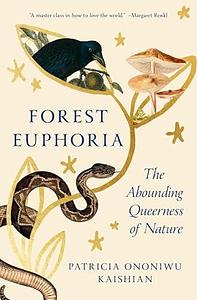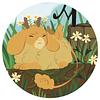Take a photo of a barcode or cover
emotional
hopeful
informative
inspiring
reflective
medium-paced
reflective
medium-paced
dark
emotional
informative
slow-paced
Minor: Sexual assault
hopeful
informative
inspiring
reflective
medium-paced
medium-paced
More memoir not enough queer nature. This book just wasn't for me.
Graphic: Child abuse, Homophobia, Sexual assault, Transphobia
emotional
informative
reflective
medium-paced
informative
reflective
relaxing
medium-paced
Minor: Child abuse, Death, Genocide, Misogyny, Pandemic/Epidemic
emotional
informative
reflective
fast-paced
True to my brand as a hater, my first thought after finishing this book was “wow this is everything ‘How Far the Light Reaches’ wanted to be but completely failed at.” And yet, it’s so true on so many levels that the more I sit with this book, the more I find that I quite enjoyed it.
Each of the creatures that this book reflects upon are known to be “unlikeable” in society, but Patricia Ononiwu Kaishian discusses these beings with such love and affection. They don’t hold back from the more violent ways in which these creatures live, but at the same time they fully celebrate the innate queerness that is so prevalent in these organisms. From the snail to the mushroom to my favorite, the eel, each chapter provides quietly eye-opening insights into the beauty found in these “unlikeable” creatures. Kaishian’s passion for these beings comes through in each and every sentence of this book, and the level of dedication into research on these creatures was so impressive.
And at the same time, Kaishian balances the nature and scientific such a vulnerable and tender exploration of their personal story. I really liked the ways in which they segued from creatures into personal memoir seamlessly in every single chapter, allowing space to explore the similarities between the two different aspects. The book’s exploration of the Armenian genocide is a topic that I feel is not discussed much, if at all, in most historical texts and especially found it insightful how the author reflected upon how their Armenian AND Irish genocide contributed so strongly to their personhood. Too often I find that diaspora stories feel so self-centered and self-serving in the sense of wanting justice for lost cultural connection, but Kaishian shies away from this rhetoric, fully embracing the place they are at in their journey with their culture.
All in all, this was an enjoyable book, straddling the line between scientific nonfiction and memoir. The writing was highly readable and compelling, though I did feel that certain moments took jarring side steps into seemingly unrelated tangents, such as the author’s critiques about the field of mycology. But as a whole, I still had fun reading and I’m definitely interested to explore more of this author’s stories in the future.
Each of the creatures that this book reflects upon are known to be “unlikeable” in society, but Patricia Ononiwu Kaishian discusses these beings with such love and affection. They don’t hold back from the more violent ways in which these creatures live, but at the same time they fully celebrate the innate queerness that is so prevalent in these organisms. From the snail to the mushroom to my favorite, the eel, each chapter provides quietly eye-opening insights into the beauty found in these “unlikeable” creatures. Kaishian’s passion for these beings comes through in each and every sentence of this book, and the level of dedication into research on these creatures was so impressive.
And at the same time, Kaishian balances the nature and scientific such a vulnerable and tender exploration of their personal story. I really liked the ways in which they segued from creatures into personal memoir seamlessly in every single chapter, allowing space to explore the similarities between the two different aspects. The book’s exploration of the Armenian genocide is a topic that I feel is not discussed much, if at all, in most historical texts and especially found it insightful how the author reflected upon how their Armenian AND Irish genocide contributed so strongly to their personhood. Too often I find that diaspora stories feel so self-centered and self-serving in the sense of wanting justice for lost cultural connection, but Kaishian shies away from this rhetoric, fully embracing the place they are at in their journey with their culture.
All in all, this was an enjoyable book, straddling the line between scientific nonfiction and memoir. The writing was highly readable and compelling, though I did feel that certain moments took jarring side steps into seemingly unrelated tangents, such as the author’s critiques about the field of mycology. But as a whole, I still had fun reading and I’m definitely interested to explore more of this author’s stories in the future.
inspiring
reflective
1,000,000 ⭐️ (and I will physically fight the current “rating” system to make that official).
This book completely wrecked me in the best way. Think Queer Ecology meets a deep, aching dive into the forests of New York (my old romping grounds) and it hit every nerve ending I have. It’s guttural, emotional, and for someone who never cries while reading, I was full on sobbing. Multiple times.
It reminded me that nature is not just beautiful, it’s fleeting. It’s something we must connect/reconnect with, protect, and preserve. This story wasn’t just a love letter to the wild, it was a rallying cry. And it wasn’t just about ecology, it was about queer identity, about community, about finding your people and finding yourself tangled up in the roots of something bigger.
I came out of this book feeling cracked open, reminded of what matters. Nature matters. Queer joy and rage and community matter. And yeah, I’m not speechless, clearly, but I am changed.
This book completely wrecked me in the best way. Think Queer Ecology meets a deep, aching dive into the forests of New York (my old romping grounds) and it hit every nerve ending I have. It’s guttural, emotional, and for someone who never cries while reading, I was full on sobbing. Multiple times.
It reminded me that nature is not just beautiful, it’s fleeting. It’s something we must connect/reconnect with, protect, and preserve. This story wasn’t just a love letter to the wild, it was a rallying cry. And it wasn’t just about ecology, it was about queer identity, about community, about finding your people and finding yourself tangled up in the roots of something bigger.
I came out of this book feeling cracked open, reminded of what matters. Nature matters. Queer joy and rage and community matter. And yeah, I’m not speechless, clearly, but I am changed.





